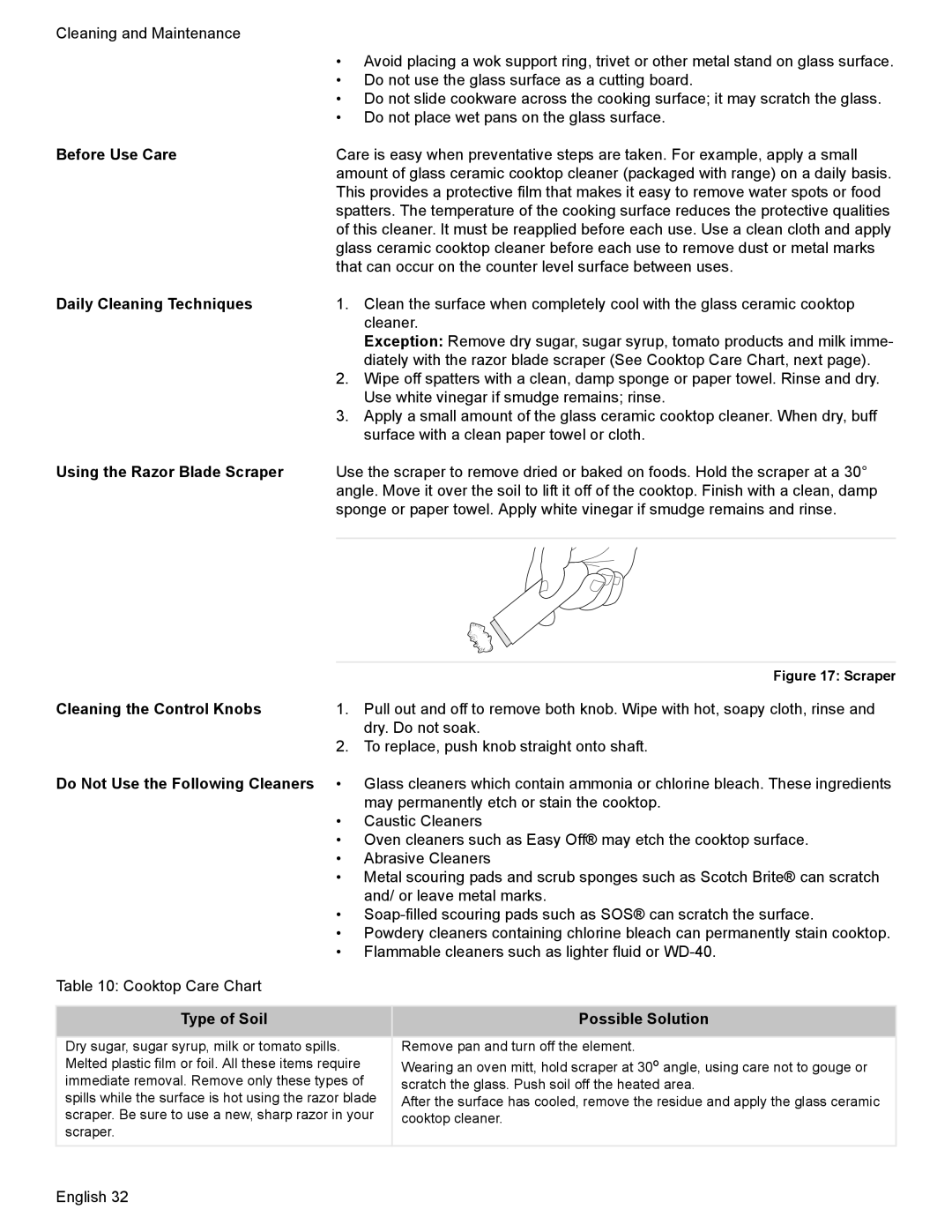
Cleaning and Maintenance |
|
|
| • | Avoid placing a wok support ring, trivet or other metal stand on glass surface. |
| • | Do not use the glass surface as a cutting board. |
| • | Do not slide cookware across the cooking surface; it may scratch the glass. |
| • | Do not place wet pans on the glass surface. |
Before Use Care | Care is easy when preventative steps are taken. For example, apply a small | |
| amount of glass ceramic cooktop cleaner (packaged with range) on a daily basis. | |
| This provides a protective film that makes it easy to remove water spots or food | |
| spatters. The temperature of the cooking surface reduces the protective qualities | |
| of this cleaner. It must be reapplied before each use. Use a clean cloth and apply | |
| glass ceramic cooktop cleaner before each use to remove dust or metal marks | |
| that can occur on the counter level surface between uses. | |
Daily Cleaning Techniques | 1. | Clean the surface when completely cool with the glass ceramic cooktop |
|
| cleaner. |
|
| Exception: Remove dry sugar, sugar syrup, tomato products and milk imme- |
|
| diately with the razor blade scraper (See Cooktop Care Chart, next page). |
| 2. | Wipe off spatters with a clean, damp sponge or paper towel. Rinse and dry. |
|
| Use white vinegar if smudge remains; rinse. |
| 3. | Apply a small amount of the glass ceramic cooktop cleaner. When dry, buff |
|
| surface with a clean paper towel or cloth. |
Using the Razor Blade Scraper | Use the scraper to remove dried or baked on foods. Hold the scraper at a 30° | |
| angle. Move it over the soil to lift it off of the cooktop. Finish with a clean, damp | |
| sponge or paper towel. Apply white vinegar if smudge remains and rinse. | |
|
|
|
|
|
| Figure 17: Scraper |
Cleaning the Control Knobs | 1. | Pull out and off to remove both knob. Wipe with hot, soapy cloth, rinse and | |
|
| dry. Do not soak. | |
| 2. | To replace, push knob straight onto shaft. | |
Do Not Use the Following Cleaners | • | Glass cleaners which contain ammonia or chlorine bleach. These ingredients | |
|
| may permanently etch or stain the cooktop. | |
| • | Caustic Cleaners | |
| • | Oven cleaners such as Easy Off® may etch the cooktop surface. | |
| • | Abrasive Cleaners | |
| • | Metal scouring pads and scrub sponges such as Scotch Brite® can scratch | |
|
| and/ or leave metal marks. | |
| • | ||
| • | Powdery cleaners containing chlorine bleach can permanently stain cooktop. | |
| • | Flammable cleaners such as lighter fluid or | |
Table 10: Cooktop Care Chart |
|
|
|
|
|
|
|
Type of Soil |
|
| Possible Solution |
|
|
| |
Dry sugar, sugar syrup, milk or tomato spills. |
| Remove pan and turn off the element. | |
Melted plastic film or foil. All these items require |
| Wearing an oven mitt, hold scraper at 30o angle, using care not to gouge or | |
immediate removal. Remove only these types of |
| scratch the glass. Push soil off the heated area. | |
spills while the surface is hot using the razor blade | After the surface has cooled, remove the residue and apply the glass ceramic | ||
scraper. Be sure to use a new, sharp razor in your | cooktop cleaner. | ||
scraper. |
|
|
|
|
|
|
|
English 32
